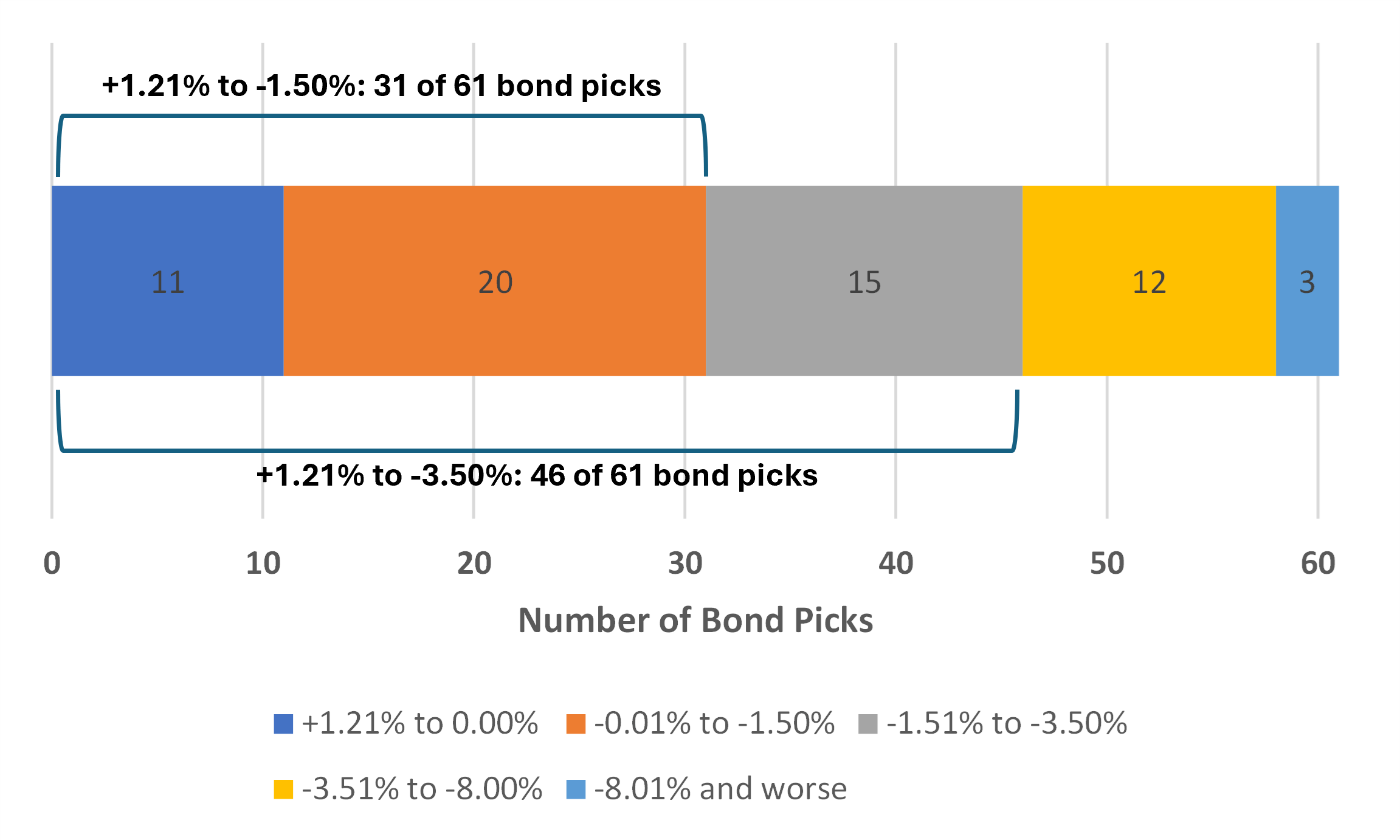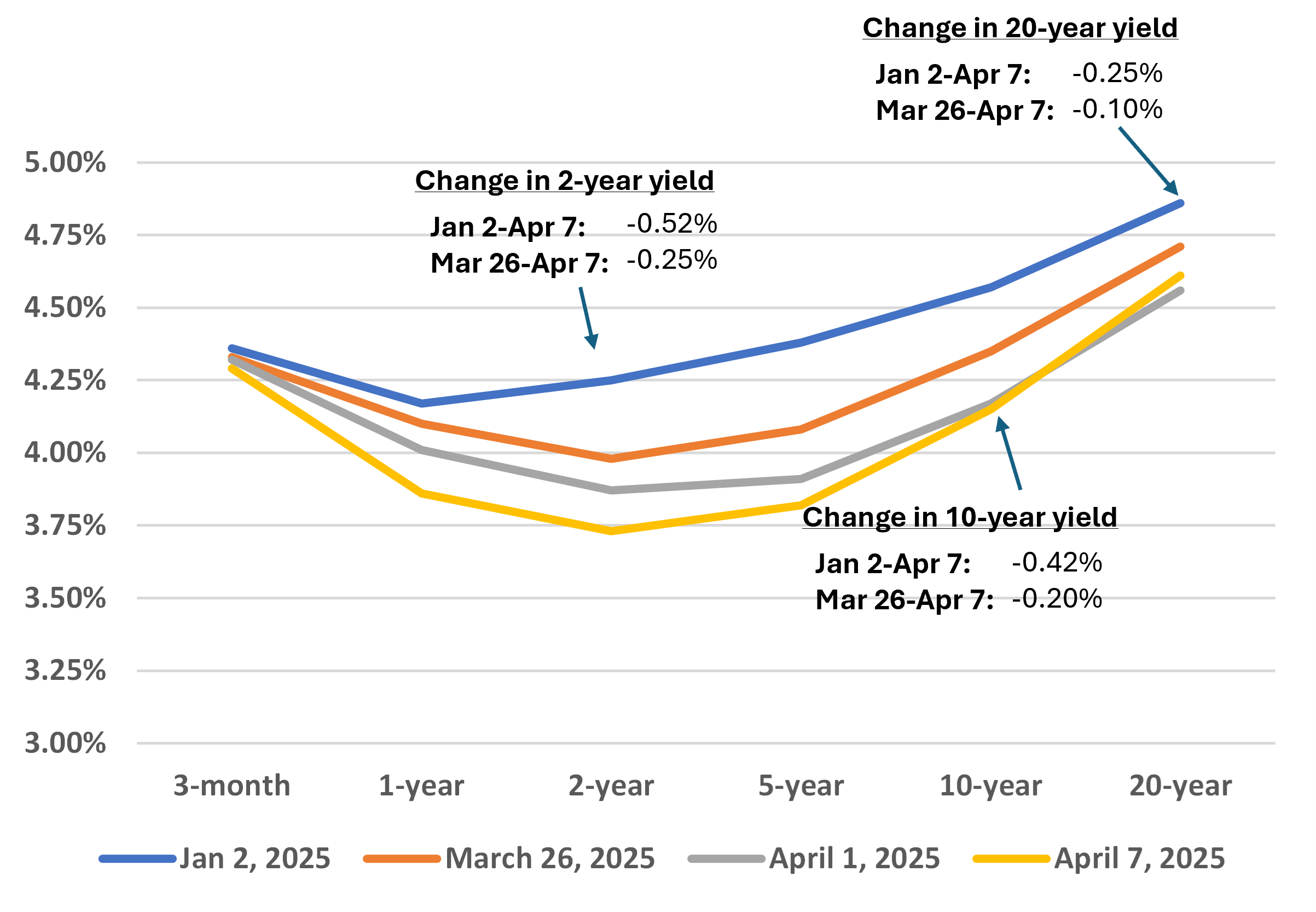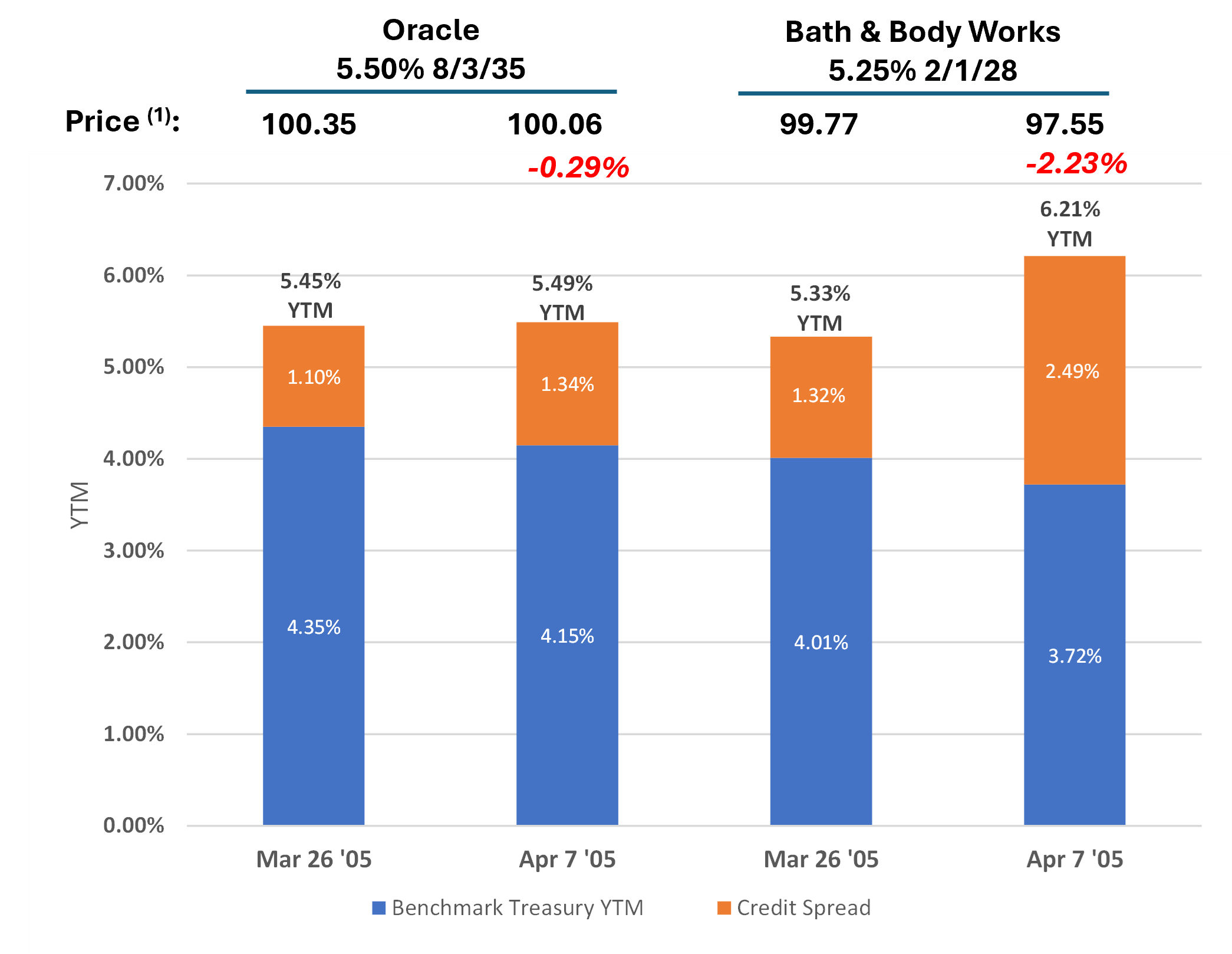As stock markets plummeted in the wake of President Trump's April 2 tariff announcements, corporate bond prices held relatively steady. From March 26 to April 7, the S&P 500 and Nasdaq 100 indices fell 11.3% and 12.5%, respectively. During this time, the median Bondsavvy corporate bond recommendation fell 1.5%.
What's more, the median YTM of a Bondsavvy-recommended bond was 5.96% on April 7, nearly 5x higher than the S&P 500 dividend yield. Individual bonds' contractual, fixed payments are a key advantage over stock dividends, which are generally low and can be paused or slashed overnight, as they were during the Covid-19 pandemic.
While stocks surged on April 9 after President Trump announced a 90-day pause on most so-called "reciprocal tariffs," we wrote this fixed income blog post to show how individual corporate bonds performed during an extraordinarily bad time for stocks. In a highly uncertain time for stocks, investors must consider the contractual income, principal protection, and opportunities for capital growth corporate bonds can provide.
How Bondsavvy Bond Picks Are Reacting to Trump Tariffs
Figure 1 shows the performance of Bondsavvy's current 61 corporate bond recommendations between March 26 and April 7, 2025. Each bar shows the number of our bond recommendations within each performance range. For example, 20 of our 61 bond recommendations (the orange bar) had price changes of -0.01% to -1.50% from March 26 to April 7.
For 46 of our current 61 corporate bond recommendations, the price change was +1.21% to -3.50%. We had three high yield bond recommendations that fell over 8.00% during this period (the light-blue bar). This performance compares to the 11.3% decline in the S&P 500 and the 12.5% decline in the Nasdaq 100 index.
Figure 1: March 26 to April 7, 2025 Range of Performance for Bondsavvy-Recommended Corporate Bonds

Sources: FINRA TRACE data, market prices on Fidelity.com, and Bondsavvy calculations. Past performance does not guarantee future results.
We show our performance during this time period, as: 1) we used March 26's closing bond prices to provide our March 27 bond recommendation updates to Bondsavvy subscribers and 2) April 7 was the third-consecutive day of losses following the April 2 Trump tariff announcements.
Please note that this fixed income blog post reflects a snapshot in time. Financial markets have been highly volatile with the recent tariff announcements, so we plan to update this fixed income blog post in the future.
How Stocks and Bonds Reacted to Trump's Tariffs
Bondsavvy updated its 61 corporate bond recommendations March 27 during its Super Bondcast investment webinar. These updates included bond prices as of market close March 26, which was the 'calm before the new-tariff storm.' As we show in Figure 2, the S&P 500 and Nasdaq 100 ETFs fell 11.3% and 12.5%, respectively, from March 26 to April 7, 2025. During this time, the median Bondsavvy corporate bond recommendation fell 1.5%.
 Click here to get four prior bond pick updates.
Click here to get four prior bond pick updates.
A key advantage of individual bonds over stocks is their substantially higher yields. As shown in Figure 2, the median YTM of a Bondsavvy recommendation as of April 7 was 5.96%, which was 4.7x and 8.5x higher than the yields of the S&P 500 and Nasdaq 100 ETFs. Some investors might consider bond funds vs. individual bonds; however, bond fund distributions are variable and can vary significantly over the life of an investment. In addition, they do not trade relative to par value and lack underlying financials, so it is impossible for investors to assess their value when making investment decisions.
Figure 2: Stock and Bondsavvy Performance After Trump Tariff Announcement
Investment | March 26-April 7,
2024 Decline 1 | Yield 2 |
|---|
| S&P 500 IVV ETF | -11.3% | 1.28% |
| Nasdaq 100 QQQ ETF | -12.5% | 0.70% |
| Bondsavvy Buy/Hold Bond Picks | -1.5% 1 | 5.96% |
1 Represents the median price decline for the 61 Bondsavvy recommendations rated buy or hold as of March 26. The average decline was -2.3%.
2 For the IVV ETF, represents the trailing 12-month dividend yield as of February 28, 2025. For the QQQ ETF, represents the 12-month dividend yield as of April 7, 2025. Bondsavvy bond pick data represents the median YTM of our recommendations rated buy or hold as of April 7, 2025.
Sources: iShares, Invesco, and Bondsavvy. IVV price changes are from iShares and QQQ price changes are from Yahoo! Finance.
How Treasury and Corporate Bond Yields Have Reacted to Trump's Tariffs
A corporate bond YTM consists of the "benchmark US Treasury yield" and the corporate bond's credit spread. The benchmark US Treasury yield is the YTM of a US Treasury bond, note, or bill that has a similar maturity date of a corporate bond (more on this later). Movements in US Treasurys and corporate bond credit spreads impact a corporate bond's YTM and, in turn, its price relative to par value.
Changes in US Treasury Yields Driven by Trump Tariffs
Figure 3 shows the US Treasury yield curves for January 2, March 26, April 1, and April 7, 2025. As shown, the three-month US Treasury yield has hardly budged all year, starting the year at 4.36% and closing at 4.31% on April 7. The more-pronounced moves have been in the 2- and 10-year Treasury yields, which fell 52 and 42 basis points from January 2 to April 7. For both of these securities, about half of the decline came before March 26 and half was from March 26 to April 7.
Figure 3: US Treasury Yield Curves on January 2, March 26, April 1, and April 7, 2025

Source: US Treasury data presented by Bondsavvy.
Changes in Corporate Bond Credit Spreads Driven by Trump Tariffs
While US Treasury yields generally fell between March 26 and April 7, 2025, in many cases, this decline was often offset by credit spread increases. If a credit spread increase is more than the benchmark US Treasury yield decrease, the corporate bond's YTM will increase, and the bond price will fall. Figure 4 provides two examples to show how the Trump tariffs impacted individual corporate bonds. We show an investment-grade bond, Oracle 5.50% due 8/3/35 (CUSIP 68389XDA0), and a high yield bond, Bath & Body Works 5.25% due 2/1/28 (CUSIP 501797AN4).
In the case of a stock market collapse, US Treasury yields will often fall due to a "flight to quality," and corporate bond credit spreads often increase due to perceived higher risk in the market. As shown in Figure 4, in the Oracle '35 bond, the benchmark US Treasury yield decreased 20 basis points from 4.35% to 4.15% (the blue bars), but the credit spread increased 24 basis points to 1.34% (the orange bars). These changes offset each other, resulting in a small 4-basis-point increase in the Oracle bond's YTM and a 0.29% price decline, from 100.35 to 100.06.
Figure 4: Corporate Bond Price Changes from Trump Tariffs - March 26 to April 7, 2025

Source: Fidelity.com and US Treasury data as presented by Bondsavvy.
1 Prices represent the trading day's last customer-sell trades for the Oracle '35 bond and the day's last customer-buy trades for the Bath & Body Works '28 bond.
Figure 4 also shows how a high yield bond, Bath & Body Works 5.25% due 2/1/28, reacted to the Trump tariff announcements. As discussed above, many shorter-dated US Treasury yields fell more than the 10-year US Treasury. The Bath & Body Works '28 bond has a three-year maturity, and, between March 26 and April 7, the benchmark US Treasury note fell 29 basis points.
In the aftermath of the Trump tariff announcements, many high yield bond credit spreads increased significantly. In the case of the Bath & Body Works '28 bond, the credit spread increased 117 basis points to 2.49%, as shown in Figure 4. The credit spread increase and benchmark Treasury decrease drove an 88-basis-point increase in the Bath & Body bond's YTM to 6.21% and a 2.23% decline in the bond's price.
The 0.29% and 2.23% declines in the Oracle '35 and Bath & Body Works '28 bonds were muted relative to the 11.3% and 12.5% declines in the S&P 500 and Nasdaq 100 indices from March 26 to April 7, 2025.
Why Own a Corporate Bond Rather Than a Stock
Many investors thinking of owning individual bonds often gravitate to US Treasurys. With US corporate bonds, however, investors can benefit from higher coupons and bond yields and lower interest rate risk.
Investing in stocks vs. corporate bonds does not have to be a mutually exclusive decision, as these investments can accomplish different objectives. Indeed, stocks generally offer greater upside than corporate bonds, as bond prices must return to par value at the maturity date. That said, there is a world of difference between a fixed corporate bond coupon of, say, 6%, and a stock's 1.2% dividend yield. Over time, investors can invest interest income in more corporate bonds and enjoy significantly higher levels of compound interest than is possible with dividend income.
Since corporate bonds trade relative to par value, investors can use Bondsavvy's corporate bond research to compare a bond's price, YTM, and credit spread to key financial metrics such as leverage ratios. They can do this to assess a bond's value, something that is not possible with bond fund and bond ETF investments.
In addition, there are significantly more individual corporate bonds than stocks, offering investors a variety of investments that can achieve various investment objectives. There are short-term investment grade corporate bonds offering principal protection and income. There are many deeply discounted, long-dated investment grade bonds that offer high income and opportunities for capital appreciation. And there are high yield bonds that offer high income, capital growth opportunities, and greater principal protection than stocks.
With corporate bonds, investors can benefit from income, principal protection, and potential capital growth: an investing trifecta. With stocks, investors can typically only achieve one of these objectives.
Get Started
Watch Free Sample